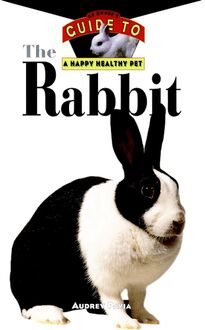-
 Univers
Univers
-
 Ebooks
Ebooks
-
 Livres audio
Livres audio
-
 Presse
Presse
-
 Podcasts
Podcasts
-
 BD
BD
-
 Documents
Documents
-
- Cours
- Révisions
- Ressources pédagogiques
- Sciences de l’éducation
- Manuels scolaires
- Langues
- Travaux de classe
- Annales de BEP
- Etudes supérieures
- Maternelle et primaire
- Fiches de lecture
- Orientation scolaire
- Méthodologie
- Corrigés de devoir
- Annales d’examens et concours
- Annales du bac
- Annales du brevet
- Rapports de stage
La lecture à portée de main
Vous pourrez modifier la taille du texte de cet ouvrage
Découvre YouScribe en t'inscrivant gratuitement
Je m'inscrisDécouvre YouScribe en t'inscrivant gratuitement
Je m'inscrisEn savoir plus
Vous pourrez modifier la taille du texte de cet ouvrage
En savoir plus

Description
- feeding
- housing
- grooming
- health care
- what to expect from the pet
- basic training
In addition, owners of more unusual pets will particularly appreciate the expert advice in these books because professional care for their animals may be difficult to come by. As always, the instruction is from experts—people who know their pet intimately, but also remember what it was like to have one for the first time. Happy, Healthy Pet guides are rich with professional quality color photos and are designed to be enjoyable and easy to learn from.
PART ONE: Welcome to the World of the Quaker Parrot.
1. What Is a Parrot?
2. All About Quaker Parrots.
3. Why Choose a Quaker Parrot?
PART TWO: Living with a Quaker Parrot.
4. Setting Up Your Quaker Parrot's Home.
5. Bringing Your Bird Home.
6. Feeding Your Quaker Parrot.
7. Preventive Care for Your Quaker Parrot.
8. Your Quaker Parrot's Health.
PART THREE: Enjoying Your Quaker Parrot.
9. Having Fun with Your Quaker Parrot.
10. Answers for New Owners.
PART FOUR: Beyond the Basics.
11. References.
Sujets
Informations
| Publié par | Turner Publishing Company |
| Date de parution | 21 avril 2008 |
| Nombre de lectures | 0 |
| EAN13 | 9780470335741 |
| Langue | English |
| Poids de l'ouvrage | 2 Mo |
Informations légales : prix de location à la page 0,0750€. Cette information est donnée uniquement à titre indicatif conformément à la législation en vigueur.
Extrait
The Quaker Parrot
Howell Book House
Copyright 1998 by Wiley Publishing, Inc. All rights reserved
Howell Book House
Published by Wiley Publishing, Inc., Hoboken, NJ Published simultaneously in Canada
No part of this publication may be reproduced, stored in a retrieval system, or transmitted in any form or by any means, electronic, mechanical, photocopying, recording, scanning, or otherwise, except as permitted under Section 107 or 108 of the 1976 United States Copyright Act, without either the prior written permission of the Publisher, or authorization through payment of the appropriate per-copy fee to the Copyright Clearance Center, 222 Rosewood Drive, Danvers, MA 01923, (978) 750-8400, fax (978) 646-8600, or on the web at www.copyright.com . Requests to the Publisher for permission should be addressed to the Legal Department, Wiley Publishing, Inc., 10475 Crosspoint Blvd., Indianapolis, IN 46256, (317) 572-3447, fax (317) 572-4447.
Limit of Liability/Disclaimer of Warranty: While the publisher and the author have used their best efforts in preparing this book, they make no representations or warranties with respect to the accuracy or completeness of the contents of this book and specifically disclaim any implied warranties of merchantability or fitness for a particular purpose. No warranty may be created or extended by sales representatives or written sales materials. The advice and strategies contained herein may not be suitable for your situation. You should consult with a professional where appropriate. Neither the publisher nor the author shall be liable for any loss of profit or any other commercial damages, including but not limited to special, incidental, consequential, or other damages.
For general information about our other products and services, please contact our Customer Care Department within the United States at (800) 762-2974, outside the United States at (317) 572-3993 or fax (317) 572-4002.
Library of Congress Cataloging-in-Publication data
Higdon, Pamela Leis.
The quaker parrot: an owner s guide to a happy, healthy pet
/ Pamela Leis Higdon.
p.cm.
ISBN 0-87605448-3
1. Quaker Parrots. I. Title. II. Series.
SF473.M65H54 1998
636.6 865-dc21
97-41806
CIP
Manufactured in the United States of America
10 9 8 7 6 5 4
Series Director: Amanda Pisani
Series Assistant Director: Jennifer Liberts
Book Design by Michele Laseau
Cover Design by Iris Jeromnimon
Illustration by Laura Robbins
Photography:
Front cover by Eric Ilasenko
Back cover by Ren e Stockdale
Kelli Cates: 81 , 93
Sherry Lee Harris: 14
Eric Ilasenko: i , 2-3 , 5 , 10 , 17 , 18 , 21 , 30 , 38 , 40 , 42 , 43 , 44 , 52 , 58 , 61 , 62 , 74 , 91 , 94 , 100 , 113 , 115 , 121
David Schilling: 12 , 27 , 46 , 107
D. Shulman, courtesy of 33rd and Bird: 9 , 23 , 29 , 110
Ren e Stockdale: 6 , 8 , 11 , 13 , 15 , 19 , 20 , 22 , 24 , 25 , 33 , 34 , 36-37 , 39 , 41 , 45 , 48 , 49 , 50 , 54 , 55 , 56 , 59 , 65 , 67 , 69 , 71 , 73 , 77 , 78 , 79 , 80 , 82 , 83 , 84 , 86 , 87 , 88 , 89 , 95 , 96 , 97 , 101 , 102 , 104 , 108-109 , 112 , 114 , 115 , 116 , 117 , 118 , 119 , 122
Production Team: Toi Davis, Natalie Hollifield, Stephanie Hammett, Clint Lahnen, Stephanie Mohler, Dennis Sheehan, Terri Sheehan
Contents
part one
Welcome to the World of the Quaker Parrot
1 What Is a Parrot?
2 All About Quaker Parrots
3 Why Choose a Quaker Parrot?
part two
Living with a Quaker Parrot
4 Setting Up Your Quaker Parrot s Home
5 Bringing Your Bird Home
6 Feeding Your Quaker Parrot
7 Preventive Care for Your Quaker Parrot
8 Your Quaker Parrot s Health
part three
Enjoying Your Quaker Parrot
9 Having Fun with Your Quaker Parrot
10 Answers for New Owners
part four
Beyond the Basics
11 References
part one
External Features of the Quaker Parrot
chapter 1
What Is a Parrot?
Whether you have bought this book and are now sitting down to read it, or you are leafing through it considering its purchase, you are probably interested in birds. I have been fascinated with birds from childhood. Our interest makes us want to buy them and bring them home to share our lives. Sometimes we fall in love with the stories we read in books, magazines or on the Internet. Sometimes the lure of birds is generated by those we see on television, both real and computer animated. However birds came to your attention, you owe it to yourself, to your family and, most of all, to the bird you are considering to learn as much as you can about its species and about the individual bird before you bring her home.
Characteristics of Birds
I have noticed, as I m sure you have, too, that each bird species not only looks different from other birds, but also has special personality characteristics common to most of its members. Among wild birds, for instance, the various kinds of blue jays are bold and raucous; doves, on the other hand, are often timid, flying away at the slightest hint of danger. Some birds, like crows or grackles, are noisy. Others, like kinglets, chickadees or cardinals, are quiet, making only small, pleasant sounds.
Before you purchase a Quaker parrot, make sure her personality characteristics are compatible with your lifestyle.
All pet bird species are wild birds somewhere on this earth, and members of their species share certain general characteristics. For this reason, I stress to anyone considering a bird that the most important thing you can do before buying one is to make sure that the bird s personality and needs mesh with your own.
While it is true that birds do not require a daily walk, a great deal of space or a litter box, they do require love and companionship, understanding, a balanced diet and knowledgeable care. A treasured, properly cared for, healthy Quaker parrot may live as long as thirty-five to forty years. One that is poorly cared for will live less than five years.
If you have considered carefully and have chosen the right bird for your personality and lifestyle, every year with your Quaker can be a delight. You will always know what to expect and how to keep your bird happy and healthy. Her species characteristics, such as her energy level and need for companionship, will match your personality. If you ve made an educated choice, your budget can easily include the needs of your bird, and your family agrees with the addition of this feathered member and has learned how to handle her.
Is a Quaker parrot really the best bird for you? The information in this book should help you decide. As you read, consider whether the needs of this active, intelligent imp of a parrot will fit your personality and lifestyle. A close match will help to ensure that you and a Quaker parrot will make great, lifelong companions.
Early Birds: Which Came First?
The first birds lived on earth long before humans, in the days of the dinosaur during the Jurassic Period. Occupying the air with the first birds were flying reptiles, which had begun to develop about thirty-five million years before those early birds. At this time, we believe that Archeopteryx lithographica was the first feathered, flying animal, or bird. We continue to hope that later discoveries in Texas and other places around the world will turn up other links in avian history.
DID YOU KNOW?
The largest parrot in the world is the Hyacinth Macaw (about 3 feet long) from South America. The smallest is the 3-inch-long Pygmy parrot from New Guinea. South America and Australia have many native parrot species; Africa has only a few. North America had two native species, the Carolina parakeet and the Thick-billed parrot. Accounts from the 1800s report clouds of these birds. Hunters killed both types of parrots to extinction in the United States.
Populations of Thick-billed parrots still live wild in Mexico and in captivity in the United States-an exceptionally strong population resides in the Sacramento Zoo in California. Presently, attempts to re-introduce Thick-billed parrots into the southwestern United States have been largely unsuccessful.
By studying fossils, paleontologists have learned that the first birds lived about 140 million years ago in cycad forests, and were about the size of a present-day crow. Cycads are tropical and semi-tropical cone-bearing plants similar to palm trees.
Experts disagree on when parrots developed. Some accept Archeopteryx verreauxi, found in France and dating from about thirty million years ago, as the first parrot. Others believe Conuropsis fratercula, found in Nebraska and dating from twenty million years ago, is the most parrot-like of ancient birds. Fossils of other parrots found in South America date from at least one million years ago.
Today, more than 8,000 species of birds live all over the earth. Their numbers are in constant decline, however, because of the loss of habitat and the vast numbers of wild birds captured for sale as pets. Of those that remain today, about 350 species are parrots.
Parrot Characteristics
Parrots come in many shapes and sizes. The most distinctive feature they all have is their beak. The curved upper mandible that fits neatly into the lower mandible works well to break open seeds, nuts, bones and other foods relished by parrots. The tongue is thick and strong; it is used with the beak to remove foods from husks, shells or other coverings.
Parrots have broad skulls and short, skinny necks. The first time you feel a parrot neck, you may be in for a surprise. It feels like a chicken or turkey neck-thin and bony. This neck is surprisingly mobile. A parrot can move her head 180 very quickly. Like other birds, parrots have excellent eye-sight, far better than that of any human.
All parrots have beaks that are distinguished by a curved upper mandible that fits neatly into the lower mandible.
Parrots have distinctive feet, shared by only a few other birds, including woodpeckers. Two toes point forward and two point backward. This arrangement allows th
-
 Univers
Univers
-
 Ebooks
Ebooks
-
 Livres audio
Livres audio
-
 Presse
Presse
-
 Podcasts
Podcasts
-
 BD
BD
-
 Documents
Documents
-
Jeunesse
-
Littérature
-
Ressources professionnelles
-
Santé et bien-être
-
Savoirs
-
Education
-
Loisirs et hobbies
-
Art, musique et cinéma
-
Actualité et débat de société
-
Jeunesse
-
Littérature
-
Ressources professionnelles
-
Santé et bien-être
-
Savoirs
-
Education
-
Loisirs et hobbies
-
Art, musique et cinéma
-
Actualité et débat de société
-
Actualités
-
Lifestyle
-
Presse jeunesse
-
Presse professionnelle
-
Pratique
-
Presse sportive
-
Presse internationale
-
Culture & Médias
-
Action et Aventures
-
Science-fiction et Fantasy
-
Société
-
Jeunesse
-
Littérature
-
Ressources professionnelles
-
Santé et bien-être
-
Savoirs
-
Education
-
Loisirs et hobbies
-
Art, musique et cinéma
-
Actualité et débat de société
- Cours
- Révisions
- Ressources pédagogiques
- Sciences de l’éducation
- Manuels scolaires
- Langues
- Travaux de classe
- Annales de BEP
- Etudes supérieures
- Maternelle et primaire
- Fiches de lecture
- Orientation scolaire
- Méthodologie
- Corrigés de devoir
- Annales d’examens et concours
- Annales du bac
- Annales du brevet
- Rapports de stage




















